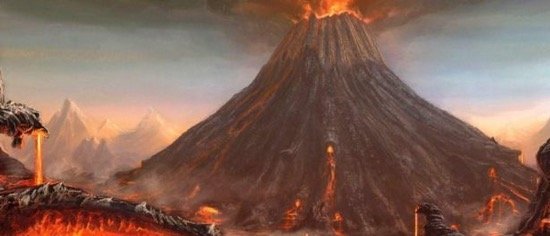Akhir Zaman. “Asap Dukhan” Yang MENGGELAPKAN Dunia Pernah Berlaku Tahun 1815 ? | Ramai tak tahu yang dunia pernah bergelap serentak akibat letusan gunung berapi di Indonesia. Bahkan setahun negara-negara Eropah tak ada musim panas. Tolong jangan abaikan artikel ni.
SEJARAH TAHUN 1815 YANG RAMAI TAK TAHU
1. Dua tiga hari ni kecoh pasal dunia akan berada dalam kegelapan.

2. Adakah pernah tercatat dalam sejarah modern bahawa telah berlaku kegelapan berpanjangan secara global? Jawapannya ialah YA.
3. Volcanic eruption di Mount Tambora Indonesia pada tahun 1815 menyebabkan Eropah berada dalam “kegelapan” pada tahun 1816.
4. How could it happen? Of course, science has provided the explanation.
5. Letupan Mount Tambora pada tahun 1815 adalah antara yang paling besar pernah tercatat, lebih besar dibandingkan dengan letupan Krakatoa pada tahun 1883.
6. Letupan yang besar memecut gas sulphur dioxide ke upper atmosphere, or stratosphere.
7. Gas sulphur dioxide bertindak balas dengan wap air membentuk sulphuric acid.
8. Lapisan kabus sulphuric acid terbentuk di upper atmosphere dan dibawa oleh angin to circle the globe.
9. Lapisan tersebut menyerap dan memantulkan cahaya matahari menyebabkan tidak cukup cukup cahaya matahari sampai ke permukaan bumi.
10. Kesannya ialah global cooling, dianggarkan suhu di Eropah turun sebanyak 3 darjah, salji turun walaupun ketika summer.
11. Kekurangan cahaya matahari juga menyebabkab tanaman tidak boleh lakukan photosynthesis, maka food chain was disrupted dan terjadi masalah kebuluran di Eropah pada tahun 1816.
12. Kadar kematian cukup tinggi. dead bodies were everywhere, kejadian malang ini inspired Mary Shelley untuk menulis buku mengenai hidupkan semula orang mati, and the book entitled Frankenstein.
Tanda-tanda hari kiamat kubra yang berikutnya adalah munculnya asap. Allah subhanahu wa Ta’ala berfirman:
فَارْتَقِبْ يَوْمَ تَأْتِي السَّمَاءُ بِدُخَانٍ مُبِينٍ (10) يَغْشَى النَّاسَ هَذَا عَذَابٌ أَلِيمٌ. الدخان: 10-11
Maka tunggulah hari ketika langit membawa kabut yang nyata, yang meliputi manusia. Inilah azab yang pedih. (ad-Dukhan: 10-11)
Sumber: PW COMMUNITY
Di Bawah Laporan Asal Dari Journal orang Barat
Mount Tambora and the Year Without a Summer
The summer of 1816 was not like any summer people could remember. Snow fell in New England. Gloomy, cold rains fell throughout Europe. It was cold and stormy and dark – not at all like typical summer weather. Consequently, 1816 became known in Europe and North America as “The Year Without a Summer.”

Why was the summer of 1816 so different? Why was there so little warmth and sunshine in Europe and North America? The answer could be found on the other side of the planet – at Indonesia’s Mount Tambora.
On April 5, 1815, Mount Tambora, a volcano, started to rumble with activity. Over the following four months the volcano exploded – the largest volcanic explosion in recorded history. Many people close to the volcano lost their lives in the event.
Mount Tambora ejected so much ash and aerosols into the atmosphere that the sky darkened and the Sun was blocked from view. The large particles spewed by the volcano fell to the ground nearby, covering towns with enough ash to collapse homes. There are reports that several feet of ash was floating on the ocean surface in the region. Ships had to plow through it to get from place to place.
But the smaller particles spewed by the volcano were light enough to spread through the atmosphere over the following months and had a worldwide effect on climate. They made their way into the stratosphere, where they could distribute around the world more easily.
Earth’s average global temperature dropped three degrees Celsius. The effect was temporary. Eventually, even the smallest particles of ash and aerosols released by the volcano fell out of the atmosphere, letting in the sunshine.
The Year Without a Summer had many impacts in Europe and North America. Crops were killed – either by frost or a lack of sunshine. This caused food to be scarce, and caused farmers who were able to grow crops to fear that they would be robbed. The lack of successful crops that summer made the food which was grown more valuable, and the price of food climbed.
Because the price of oats increased, it was more expensive for people to feed their horses. Horses were the main method of transportation, so with expensive oats, the cost of travel increased. This may have been one of the factors that inspired a German man named Karl Drais to invent a way to get around without a horse: the bicycle.
The gloomy summer weather also inspired writers. During that summer-less summer, Mary Shelley, her husband, the poet Percy Bysshe Shelley, and poet Lord Byron were on vacation at Lake Geneva.
While trapped indoors for days by constant rain and gloomy skies, the writers described the bleak, dark environment of the time in their own ways. Mary Shelley wrote Frankenstein, a horror novel set in an often stormy environment. Lord Byron wrote the poem Darkness, which begins, “I had a dream, which was not all a dream. The bright sun was extinguish’d.”
Sumber Asal: Science UCAR




